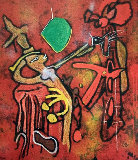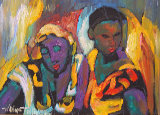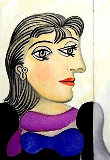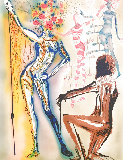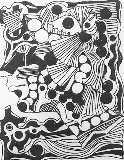-

-
Agustin Cardenas
CubaArt Brokerage: Augustine Cardenas Cuban Artist: b. 1927-2001 Cárdenas was born in 1927 in Matanzas, Cuba and was trained at the Academia de San Alejandro in Havana. He left Cuba in 1955 and settled in Paris, where he enjoyed a prosperous career and came into close contact with the Surrealists and André Breton. In 2001, he returned to Havana, where he passed away in March. As in the work of many of his compatriots, Cárdenas's work is a virtual testament to his double consciousness as a Cuban of African descent, evinced by the variation of voices encountered in his expression. Early works incorporate Surrealist tendencies in a very sensual and organic way, without any concrete reference to race or ethnicity. Later works, notably his "totems" explore the artist's African heritage more directly. Towards the very end of his career, he again reverts to abstract forms, influenced by his European environment. Early in his career, while at the San Alejandro Fine Arts Academy in Havana, Cárdenas created figurative work and was particularly interested in feminine forms. His early allegiance to avant-garde characteristics is evident in works that reference both human and animal-like forms. Much of this influence came from a non-traditional initiation into the work of avant-garde sculpture from his mentor Juan José Sicre (1898-1974). Once the official class time had ended, Sicre would show his students images of works by Hans Arp, Constantine Brancusi, and Henry Moore. Clearly, these works made an impact on the young Cárdenas, who quickly assimilated the spare, non-objective, modernist style of the avant-garde into his work. By the mid-fifties, Cárdenas was creating the works with which he would become most closely associated, exemplified by increasingly elongated forms inspired in some measure by African art. Although throughout his lifetime Cárdenas specifically denied any overt influence in African forms prior to his first trip to Paris, it was on the island in the early 1950s that he encountered a Dogon "totem" in a book of poetry. Many of his drawings from this period reveal a strong affinity with Africanizing forms. Cárdenas constructed impossibly tall, elongated objects that again mimic organic forms at the same time that they clearly referenced Africanized subject matter. By this time, Wifredo Lam's influence in Cuba would also have been extensive enough to make Cárdenas at least consider the possibility of incorporating African forms into his work. As one critic has noted: "If only accidental similarities can be discovered in the vocabulary of both Lam and Cárdenas, there nevertheless exists a deep kinship: there is the same fundamental impulsiveness, the same outbreak of inner demons, the same faith in sensuality's dynamism...There is no doubt...that both the young sculptor and his senior, the painter, entered a state of grace the day the 'African fairy' (in the words of Rimbaud), entered the Surrealist castle." (1)At the same time he was creating these totems, he retained an interest in Surrealist form, epitomizing what Edouard Glissant noted as his greatest achievement, that is the reconciliation of "a fabulous heritage with a modern tension." (2) Perhaps most evident in this respect is the influence of Roberto Matta (1912-2002), whose work Cárdenas certainly would have known in Paris. This late work, especially, reveals this influence. Like a three-dimensional element from one of Matta's innerscapes, Cárdenas's work is a dreamlike vision of the concept of a bird, perhaps about to take off in flight, perhaps preening. The soaring forms and movement alluded to in the work exemplify the power of Cárdenas as a sculptor. As is characteristic of the artist's work, this sculpture bears the constant allusion to organic forms and movement while retaining a sensibility of human scale. Le grand oisaux is a carefully-considered blending of the artist's career-long interest in a variety of media and his powerful application of marble to his aesthetic principles.Cárdenas's work, along with that of his modernist colleagues, exemplifies the diverse sources that fed the work of the avant-garde in Cuba during the first half of the twentieth century. Throughout his career, as he continued to be influenced by European models, he retained interest in the possibilities raised by both African form and Surrealist imagery. Listings wanted.
Read More + - Create Listing 0 Artworks for sale 8 Followers
-
We are actively seeking listings for Agustin Cardenas.
Create a free listing or free wanted ad.
-
Art Wanted
We have interested buyers looking for these artworks by Agustin Cardenas:
- CREATE AD
- Art Brokerage Requests (1)




